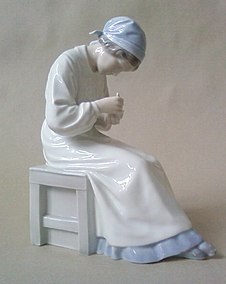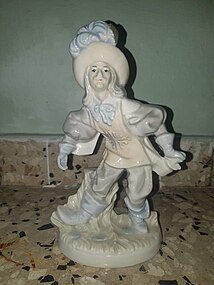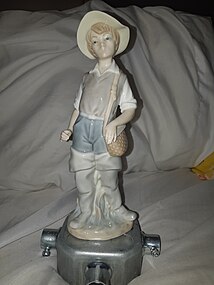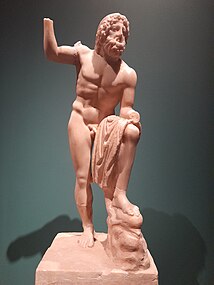Figurine
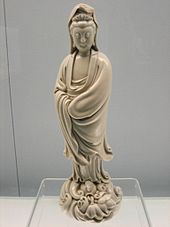
Afigurine(adiminutiveform of the wordfigure) orstatuette,is a small, three-dimensionalsculpturethat represents a human,deityoranimal,or, in practice, a pair or small group of them. Figurines have been made in many media, withclay,metal, wood, glass, and today plastic or resin the most significant. Ceramic figurines not made ofporcelainare calledterracottasin historical contexts.
Figures with movable parts, allowing limbs to be posed, are more likely to be calleddolls,mannequins,oraction figures;orrobotsorautomata,if they can move on their own. Figurines andminiaturesare sometimes used inboard games,such aschess,and tabletoprole playing games.
The main difference between a figurine and astatueis size. There is no agreed limit, but typically objects are called "figurines" up to a height of perhaps two feet (60 cm), though most types are less than one foot (30 cm) high.
Prehistory
[edit]
In China, there are extantNeolithicfigurines.[1]
European prehistoric figurines of women, some appearing pregnant, are calledVenus figurines,because of their presumed connection to fertility. The two oldest known examples are made of stone, were found in Africa and Asia,[citation needed]and are several hundred thousand years old. Many made of fired clay have been found in Europe that date to 25–30,000 BC, and are the oldestceramicsknown.
Olmec figurinesin semi-precious stones and pottery had a wide influence all overMesoamericaabout 1000–500 BC, and were apparently usually kept in houses.
These early figurines are among the first signs of human culture. One cannot know in some cases how they were used. They probably had religious or ceremonial significance and may have been used in many types of rituals. Many are found in burials. Some may have been worn asjewelryor intended to amuse children.
History
[edit]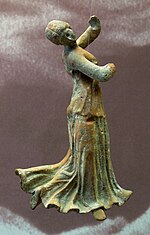
Porcelainand other ceramics are common materials for figurines. AncientGreek terracotta figurines,made in moulds, were a large industry by theHellenistic period,and ones in bronze also very common. InRoman artbronze came to predominate. Most of these were religious, and deposited in large numbers in temples asvotives,or kept in the home and sometimes buried with their owner. But types such asTanagra figurinesincluded many purely decorative subjects, such as fashionable ladies. There are many early examples fromChina,mainly religious figures inDehua porcelain,which drove the experimentation in Europe to replicate the process.
The first European porcelain figurines, were produced inMeissen porcelain,initially in a plain glazed white, but soon brightly painted inoverglaze"enamels", and were soon produced by nearly all European porcelain factories. The initial function of these seems to have been as permanent versions ofsugar sculptureswhich were used to decorate tables on special occasions by European elites, but they soon found a place on mantelpieces and side tables. There was already some production ofearthenwarefigures inEnglish delftwareandstoneware,for example byJohn Dwightof theFulham Potteryin London, and after 1720 such figures became more popular. By around 1750 pottery figures were being produced in large numbers all over Europe.Staffordshire figureswere cheaper versions inearthenware,and by the late 19th century especially noted forStaffordshire dog figurines.
Genre figurines of gallant scenes, beggars or figurines of saints are carved from pinewood inVal Gardena,South Tyrol(Italy), since the 17th century.
Significant types:
- Ushabti- Ancient Egypt, mostly placed in tombs
- Olmec figurine
- Psi and phi type figurine-Mycenaean Greece
- Euphrates Syrian Pillar FigurinesandHorses and Riders- Iron Age
- Tanagra figurines- Hellenistic Greece
- Tang dynasty tomb figures- China,c. 620–755
- Mississippian stone statuary-c. 800–1600
- Staffordshire figures- England, 1720 to present
- Santons-Provence,France, 18th century to present
- Animal figurines
- Model figure
Modern era
[edit]Modern figurines, particularly those made of plastic, are often referred to asfigures.They can encompass modernaction figuresand othermodel figuresas well asPrecious Moments figurinesandHummel figurines,Bobbleheads,Sebastian Miniaturesand other kinds of memorabilia. Some companies which produce porcelain figurines areRoyal Doulton,Lladróand Camal Enterprises.[2]
Figurines of comic book or sci-fi/fantasy characters without movable parts have been referred to by the termsinaction figures(originally used to describeKevin Smith'sView Askewfigurines) andstaction figures(aportmanteauof statue and action figures coined byFour Horsemenartists to describeMasters of the Universefigures). AlsoAmiibois a line of plastic figurines withNFCtags embedded to its base that can be used in order to interact with certain videogames forNintendoconsoles.
There is also a hobby known as mini war gaming in which players use figurines (for exampletoy soldiers) in table top based games. These figurines are mostly made of plastic and pewter. However, some premium models are made of resin.
Figurines can also represent racial and ethnic slurs, for example,Jew with a coinfigurines, and Mammy figurines.
Gallery
[edit]For more images related for "Figurine", seeCategory:Figurineson Commons
-
Minoanpraying woman in bronze, 16th century BC
-
Figurine from theMixtecculture
-
The twelveChinese zodiacfigurines
-
18th century Saint John Baptist pinewoodpolychromefigurine
-
Franz Anton Bustelli,German porcelain group
-
Porcelain painter,Royal Copenhagen
-
Fallen Astronaut,Moon
-
AMusketeerfigurine
-
Mammy figurines in the collection of theJim Crow Museum of Racist Memorabilia
-
Statuette ofPoseidon,marble
References
[edit]- ^Li Liu,The Chinese Neolithic: Trajectories to Early States,2004, Cambridge University Press, 328 pagesISBN0-521-81184-8
- ^"New range of 'gypsy wedding' figurines launched by Camal Enterprises".The Sentinel.Archived fromthe originalon 24 September 2015.Retrieved1 June2015.
 Media related toFigurinesat Wikimedia Commons
Media related toFigurinesat Wikimedia Commons






